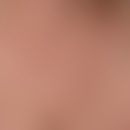Synonym(s)
DefinitionThis section has been translated automatically.
Disinfecting dye used in medicine as 8-hydroxyquinoline sulfate as an antiseptic.
Pharmacodynamics (Effect)This section has been translated automatically.
Bacteriostatic, fungicidal. Quinolinol derivatives are mainly effective against Gram-positive cocci, less effective against Gram-negative pathogens.
You might also be interested in
IndicationThis section has been translated automatically.
Standard concentrationThis section has been translated automatically.
- 0.1% solution for wound irrigation.
- 1% in ointments or powders.
Remember! Colours skin, clothing and objects yellow!
Undesirable effectsThis section has been translated automatically.
Recipe(s)This section has been translated automatically.
8-quinolinol sulfate in 0.1% solutions; furthermore 0.5-1.0% in ointments, shaking mixtures and pastes.
As a basis for formulations base cream DAC or non-ionic hydrophilic cream DAB are particularly suitable. Both bases are compatible with the cationic quinolinol sulfate and various external steroids. In aqueous cream formulations prednisolone acetate should be used as glucocorticoid exteriors (no recrystallization).
PreparationsThis section has been translated automatically.
Chinosol®, Leioderm® cream;
Note(s)This section has been translated automatically.
8-Hydroxyquinoline and its derivatives were used in the middle of the last century for diarrhea. After prolonged high-dose administration of 8-hydroxyquinoline derivatives, neurotoxic side effects were observed, especially in Japan, which were termed SMON disease (subacute myelooptic neuropathy or myelitis japonica) (neurological deficits with bladder, rectal and visual disturbances).
Recently, it has become increasingly difficult to obtain the active ingredient in adequate pharmaceutical quality; meanwhile, the substances are practically no longer available. The finished drug Chinosol® is also off the market, so that alternatives to quinolinol preparations have to be considered.
LiteratureThis section has been translated automatically.
- Oliveri V et al(2016) 8-Hydroxyquinolines in medicinal chemistry: A structural perspective. Eur J Med Chem 120:252-274.
- Prachayasittikul V et al.(2013) 8-Hydroxyquinolines: a review of their metal chelating properties and medicinal applications. Drug of Devel Ther 7:1157-1178





